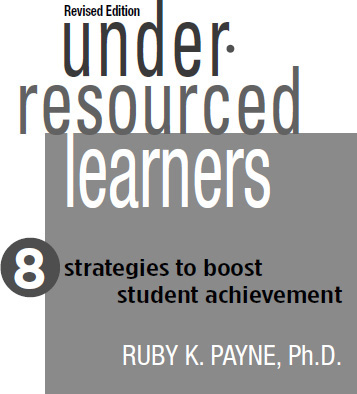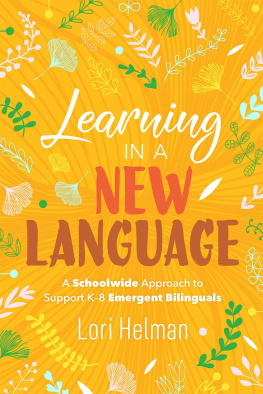Under-Resourced Learners: 8 Strategies to Boost Student Achievement. Revised Edition.
Ruby K. Payne
220 pages
Bibliography pages 201208
2008 by aha! Process, Inc. Revised 2017.
All rights reserved. No part of this book may be reproduced in any manner whatsoever without written permission, except in the case of brief quotations embedded in critical articles and reviews. For information, contact:
aha! Process, Inc.
P.O. Box 727
Highlands, TX 77562-0727
(800) 424-9484  (281) 426-5300
(281) 426-5300
Fax: (281) 426-5600
Website: www.ahaprocess.com
Copy editing by Dan Shenk and Jesse Conrad
Book design by Paula Nicolella
Cover design by Dunn+Associates
Printed in the United States of America
ISBN: 978-1-938248-89-4
eBook ISBN: 978-1-938248-94-8
Library of Congress Control Number: 2008920184
1. Education 2. Sociology 3. Title

Other Selected Titles by Ruby K. Payne, Ph.D.
A Framework for Understanding Poverty: A Cognitive Approach
Research-Based Strategies: Narrowing the Achievement Gap for Under-Resourced Learners
How Much of Yourself Do You Own?
(Payne & O'Neill-Baker)
Bridges to Health and Healthcare
(Dreussi-Smith, Payne, Shaw, Young)
From Understanding Poverty to Developing Human Capacity
Working with Parents: Building Relationships for Student Success
Working with Students: Discipline Strategies for the 21st-Century Classroom
Crossing the Tracks for Love: What to Do When You and Your Partner Grew Up in Different Worlds
Removing the Mask: How to Identify and Develop Giftedness in Students from Poverty (Slocumb & Payne)
Bridges Out of Poverty: Strategies for Professionals and Communities (Payne, DeVol, & Dreussi Smith)
What Every Church Member Should Know About Poverty (Ehlig & Payne)
Hidden Rules of Class at Work (Payne & Krabill)
Dedication
Children's Bill of Rights
The true measure of a nation's standing is how well it attends to its childrentheir health and safety, their material security, their education and socialization, and their sense of being loved, valued, and included in families and societies into which they are born.
UNICEF, Child Poverty in Perspective
This is my Bill of Rights for Children.
Every Child Has the Right
 To be safe and reside in a violence-free environment
To be safe and reside in a violence-free environment
 To be nurtured and loved by at least one caring adult
To be nurtured and loved by at least one caring adult
 To have appropriate healthcare
To have appropriate healthcare
 To have nutritious food every day
To have nutritious food every day
 To have stable shelter every night
To have stable shelter every night
 To have an education
To have an education
Unqualified support for these rights is imperative to a healthy, safe societyindeed, to the future of our nation. Children are our future.
Introduction
The purpose of Under-Resourced Learners: 8 Strategies to Boost Student Achievement is to provide practical tools to educators to address the needs of under-resourced learners.
The first book I wrote, A Framework for Understanding Poverty, looked at resources as they related to the three economic classes: poverty, middle class, and wealth. Since that time, many individuals have said to me, I know students who have so many things, but they aren't doing well in school. In this book I elaborate on that frame of reference and say that students can be resourced or under-resourced, regardless of money.
Under-Resourced Learners is intended to give some tangible tools to individuals who teach students in schools of the United States. UNICEF (an arm of the United Nations) uses resources as a measurement to determine stability, and it is legitimate. In the UNICEF report An Overview of Child Well-Being in Rich Countries, the concept of resources is used to identify well-being. I would note that under-resourced is terminology directly from the United Nations and is a way to talk about students who don't have access to a number of the resources necessary for school success.
At the end of each chapter I present a series of practical steps you can take in relation to the strategies outlined in that chapter. You may wish to integrate them with techniques and strategies already working for you and your colleagues.
This book does not presume that schools can fix everything, so the focus necessarily is on the resources that can be developed in schools.
In the UNICEF report Child Poverty in Perspective, the concept of resources is used to identify well-being. In the report, the European Union offers this definition of poverty: The poor are those whose resources (material, cultural, and social) are so limited as to exclude them from the minimum acceptable way of life in the Member States in which they live (page 6).
In this revised edition you will now find an Under-Resourced Learners study guide in there are PowerPoint slides to use in teacher training. A number of the training strategies (charts, diagrams, and forms) are referenced earlier in the text of the book.
Strategy 1
Assess Resources of Individual Students to Determine Interventions
When I did my resources self-assessment, I realized that money was not my only problem. I always knew money wasn't going to solve all of my problems, but I thought it would solve most of the big ones. I realized that was not going to be true. It really hit me hard. I even had to step away from it for a few minutes because the reality of my situation hit me square in the face. It was one of those aha momentsyou know, the ones where you go Aha, that's why I've been doing that. It was great and scary and heartbreaking and exhilarating and everything all at one moment. It was one of the hardest things I had to do but definitely the most beneficial. I now try to do a self-assessment about every six months to see what progress I've made.
Mary Gruza, Getting Ahead Graduate
I've always believed that the Ruby Payne model explained why it was so important to examine the different resources that children and families have or don't have. The model also suggests various ways you can embed other resources to help children be more successful.
Kelly Sharp, Sixth-Grade Language Arts/Social Studies Teacher
Why Look at Resources?
It isn't possible to educate well just by teaching the group and not knowing about the individual students in the classroom. Many students get identified as at risk when the issue is one of resources. When you know the resources of an individual, then you can determine the intervention(s) that will work best. Interventions that are successful work with the individual's strengths to enhance underdeveloped resources.
What Does It Mean to Be Under-Resourced? Is It a Personal Issue or a Situational Issue?
It is both. All individuals have an area or areas in their life where they would like to have more resources, i.e., more athletic abilities and better eyesight or be taller, shorter, smarter, quicker, etc.

















 (281) 426-5300
(281) 426-5300